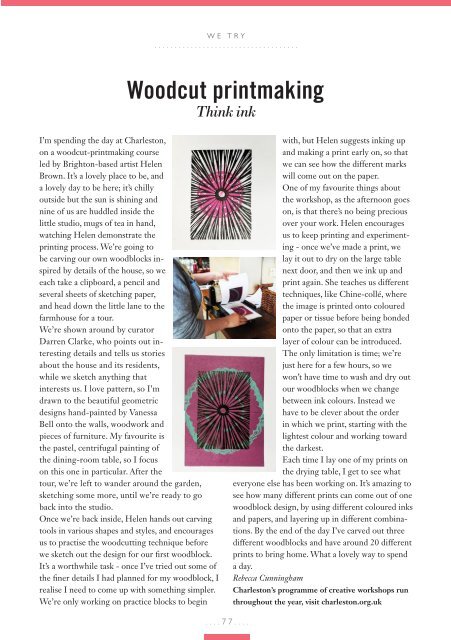Viva Brighton Issue #52 June 2017
Create successful ePaper yourself
Turn your PDF publications into a flip-book with our unique Google optimized e-Paper software.
WE TRY<br />
....................................<br />
Woodcut printmaking<br />
Think ink<br />
I’m spending the day at Charleston,<br />
on a woodcut-printmaking course<br />
led by <strong>Brighton</strong>-based artist Helen<br />
Brown. It’s a lovely place to be, and<br />
a lovely day to be here; it’s chilly<br />
outside but the sun is shining and<br />
nine of us are huddled inside the<br />
little studio, mugs of tea in hand,<br />
watching Helen demonstrate the<br />
printing process. We’re going to<br />
be carving our own woodblocks inspired<br />
by details of the house, so we<br />
each take a clipboard, a pencil and<br />
several sheets of sketching paper,<br />
and head down the little lane to the<br />
farmhouse for a tour.<br />
We’re shown around by curator<br />
Darren Clarke, who points out interesting<br />
details and tells us stories<br />
about the house and its residents,<br />
while we sketch anything that<br />
interests us. I love pattern, so I’m<br />
drawn to the beautiful geometric<br />
designs hand-painted by Vanessa<br />
Bell onto the walls, woodwork and<br />
pieces of furniture. My favourite is<br />
the pastel, centrifugal painting of<br />
the dining-room table, so I focus<br />
on this one in particular. After the<br />
tour, we’re left to wander around the garden,<br />
sketching some more, until we’re ready to go<br />
back into the studio.<br />
Once we’re back inside, Helen hands out carving<br />
tools in various shapes and styles, and encourages<br />
us to practise the woodcutting technique before<br />
we sketch out the design for our first woodblock.<br />
It’s a worthwhile task - once I’ve tried out some of<br />
the finer details I had planned for my woodblock, I<br />
realise I need to come up with something simpler.<br />
We’re only working on practice blocks to begin<br />
with, but Helen suggests inking up<br />
and making a print early on, so that<br />
we can see how the different marks<br />
will come out on the paper.<br />
One of my favourite things about<br />
the workshop, as the afternoon goes<br />
on, is that there’s no being precious<br />
over your work. Helen encourages<br />
us to keep printing and experimenting<br />
- once we’ve made a print, we<br />
lay it out to dry on the large table<br />
next door, and then we ink up and<br />
print again. She teaches us different<br />
techniques, like Chine-collé, where<br />
the image is printed onto coloured<br />
paper or tissue before being bonded<br />
onto the paper, so that an extra<br />
layer of colour can be introduced.<br />
The only limitation is time; we’re<br />
just here for a few hours, so we<br />
won’t have time to wash and dry out<br />
our woodblocks when we change<br />
between ink colours. Instead we<br />
have to be clever about the order<br />
in which we print, starting with the<br />
lightest colour and working toward<br />
the darkest.<br />
Each time I lay one of my prints on<br />
the drying table, I get to see what<br />
everyone else has been working on. It’s amazing to<br />
see how many different prints can come out of one<br />
woodblock design, by using different coloured inks<br />
and papers, and layering up in different combinations.<br />
By the end of the day I’ve carved out three<br />
different woodblocks and have around 20 different<br />
prints to bring home. What a lovely way to spend<br />
a day.<br />
Rebecca Cunningham<br />
Charleston’s programme of creative workshops run<br />
throughout the year, visit charleston.org.uk<br />
....77....


















